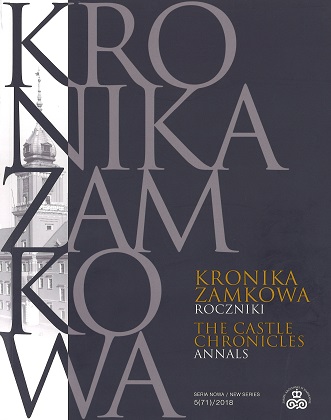Philip II Holbein – złotnik i agent artystyczny Zygmunta III w świetle dokumentów z Národní archiv w Pradze.
Philip II Holbein – goldsmith and art agentto Sigmund III in light of documents from the Národní archiv in Prague.
Author(s): Jacek ŻukowskiSubject(s): History of Art
Published by: Arx Regia® Wydawnictwo Zamku Królewskiego w Warszawie – Muzeum
Keywords: Sigmund III; Constance of Austria; Rudolf II; Philipp II Holbein; silver tableware; Augsburg; Krakow
Summary/Abstract: In 1607, on pretext of unpaid customs duty, on the border with the Polish-Lithuanian Commonwealth of imperial officials confiscated silver tableware of the Polish royal court, entrusted to the care of goldsmith Philipp II Holbein (1553–1632). Commissioned by Queen Constance, the artist was to rework the ceremonial vessels, most of which had formerly belonged to Anna Habsburg (d. 1598), and gifts from representatives of Polish nobility. The silverware were to be “refined or reworked in a Nuremberg or Augsburg fashion”. The set was made up of e.g. 72 silver large bowls bearing the coat of arms of Anna Habsburg, 38 tankards, 5 sets of bowls with pitchers, 8 silver flasks, 2 bigger flasks on chains, 4 gilt serving plates, a silver ewer (partially gilt), a cupboard plate, and a water kettle. The collection moreover included late Mannerist tableware, such as three decorative galleys, a figural group with virgins and the Cupid, a lamp with the motif of a deer, and a gilt rooster. A way out of the problem was found only in the summer of 1609, and most of the confiscated artefacts reached their destination. The dispute between the emperor and the king, taking place in the period 1607–1609, was no doubt indirectly triggered by the antagonisms between increasingly sick Rudolf II and his brother Matthias Habsburg. As early as 1605, as S.R.M. jubilerus, Holbein was present in Krakow, where together with his wife he ran “open shops with silverware”. In time, he would sign documents as “Philipp Holbein, Their Royal Highnesses in Poland and Sweden court servant and agent in Augsburg”. He was an intermediary e.g. during Sigmund III’s acquisition of jeweller’s items. It was most likely thanks to the recommendation by the Polish king that the goldsmith started to render his services to Emperor Rudolf II and then of Matthias. Published original records from the Národní archiv in Prague are but significant excerpts concerning the dispute about the royal silverware. The entire file includes at least 53 documents of letters of Sigmund and Constance of Austria (to Maria Anna of Bavaria, the emperor, archdukes Ferdinand, Matthias and Leopold of Tirol, and to councillors, judges and judicial associates of the Bohemian Customs Chamber), the correspondence and patents of Holbein and court envoys, finally letters by Rudolf II and copies of his officials’ files.
Journal: Kronika Zamkowa. Roczniki
- Issue Year: 5/2018
- Issue No: 5
- Page Range: 21-43
- Page Count: 23
- Language: Polish

